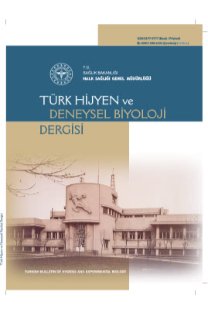RT-PCR ile pozitif saptanan COVID-19 vakalarının değerlendirilmesi
Evaluation of COVID-19 cases detected positive by RT-PCR
___
- 1. Sijia T, Nan H, Jing L, Kun C, Xuqin K, Zhenjun X et al. Characteristics of COVID-19 infection in Beijing. J Infect, 2020; 80(4): 401–406.
- 2. Nanshan C, Min Z, Xuan D, Jieming Q, Fengyun G, Yang H, et al. Epidemiological and clinical characteristics of 99 cases of 2019 novel coronavirus pneumonia in Wuhan, China: a descriptive study. Lancet, 2020; 395(10223): 507–513.
- 3. Huilan T, Sheng T, Shiqi G, Anwen S, Jifang S. The epidemiological and clinical features of COVID-19 and lessons from this global infectious public health event. J Infect, 2020; 81(1): 1-9.
- 4. Chih-Cheng L, Tzu-Ping S, Wen-Chien K, Hung-Jen T, Po-Ren H. Severe acute respiratory syndrome coronavirus 2 (SARS-CoV-2) and coronavirus disease-2019 (COVID-19): The epidemic and the challenges. Int J Antimicrob Agents, 2020; 55(3): 105924.
- 5. Rui L, Huan H, Fang L, Zhihua L, Kailang W, Yingle L, et al. Positive rate of RT-PCR detection of SARS-CoV-2 infection in 4880 cases from one hospital in Wuhan, China, from Jan to Feb 2020. Clin Chim Acta, 2020; 505: 172-175.
- 6. Qun L, Xuhua G, Peng W, Xiaoye W, Lei Z, Yeqing T et al. Early Transmission Dynamics in Wuhan, China, of Novel Coronavirus–Infected Pneumonia. N Engl J Med, 2020; 382(13): 1199–1207.
- 7. Jingchun F, Xiaodong L, Guojun S, Junpin Q, Yi L, Weimin P, et al. The epidemiology of reverse transmission of COVID-19 in Gansu Province, China. Travel Med Infect Dis, 2020; 37: 101741.
- 8. Chen W, Peter WH, Frederick GH, George FG. A novel coronavirus outbreak of global health concern. Lancet, 2020; 395(10223): 470–473.
- 9. Haneen A, Ghina’a I Abu D, Alaa A A A, Kamal D, Murtaza M T. COVID-19 pandemic: an overview of epidemiology, parthenogenesis, diagnostics and potential vaccines and therapeutics. Ther Deliv, 2020; 11(4): 245-268.
- 10. MOH, TurkeyScientific Advisory Board. COVID-19 (SARS-CoV-2 Infection) General Information, Epidemiology and Diagnosis. Turkey: Ministry of Health, General Directorate of Public Health; 27 November 2020.
- 11. Nolan T, Hands RE, Bustin SA. Quantification of mRNA using real-time RT-PCR. Nat Protoc, 2006; 1(3): 1559–1582.
- 12. Görgülü Ö , Duyan M. rRT-PCR Results of a Covid-19 Diagnosed Geriatric Patient. SN Compr Clin Med, 2020; 2(11): 2423-2426.
- 13. Kampf G, Todt D, Pfaender S, Steinmann E. Persistence of coronaviruses on inanimate surfaces and their inactivation with biocidal agents. J Hosp Infect, 2020; 104(3): 246–251.
- 14. Zhoukun L, Xi X, Qingxin G, Lieguang Z, Liangping L, Xiaoping T, et al. Asymptomatic SARS-CoV-2 infected patients with persistent negative CT findings. Eur J Radiol, 2020; 126:108956.
- 15. Ma Y, Xu QN, Wang FL, Ma XM, Wang XY, Zhang XG. Characteristics of asymptomatic patients with SARS-CoV-2 infection in Jinan, China. Microb Infect, 2020; 22: 212–217.
- 16. Görgülü Ö, Duyan M. Effects of comorbid factors on prognosis of three different geriatric groups with COVID-19 diagnosis. SN Compr Clin Med, 2020; 2(12): 2583-2594.
- 17. Karageçili H, Yıldırım Z. Epidemiological and clinical aspects of the COVID-19 pandemic and world common experiences in treatment: Turkey experience. Turk Hij Den Biyol Derg, 2020; 77(3): 355-366.
- 18. Michael L, Andrea M, Vincent M. Functional assessment of cell entry and receptor usage for SARS-CoV-2 and other lineage B betacoronaviruses. Nat Microbiol, 2020; 5(4): 562-569.
- 19. Rinkoo D, Stefan RB, Ali El-A, Roman NR, Alexander M, Ben W, et al. The ACE-2 in COVID-19: Foe or Friend? Horm Metab Res, 2020; 52(5): 257-263.
- 20. Giuseppe P, Alessandro S, Chiara P, Federica B, Romualdo Del B, Fabio C, et al. COVID 19 diagnosis and management: a comprehensive review. J Intern Med, 2020; 288(2): 192-206.
- 21. Chadia H, Sandrella Bou M, Hala S, Pascale S. Smoking and COVID-19: A Scoping Review. Tob Use Insights, 2021; 14: 1179173X21994612.
- 22. Usman MS, Siddiqi TJ, Khan MS, Patel UK, Shahid I, Ahmed J, et al. Is there a smoker’s paradox in COVID-19? BMJ Evid Based Med, 2020;26(6):279-84.
- 23. Chaolin H, Yeming W, Xingwang L, Lili R, Jianping Z, Yi H, et al. Clinical features of patients infected with 2019 novel coronavirus in Wuhan, China. Lancet, 2020; 395(10223): 497-506.
- 24. Di W, Tiantian W, Qun L, Zhicong Y. The SARS-CoV-2 outbreak: What we know. Int J Infect Dis, 2020; 94: 44-48.
- ISSN: 0377-9777
- Yayın Aralığı: 4
- Başlangıç: 1938
- Yayıncı: Türkiye Halk Sağlığı Kurumu
Yatan hasta yakınlarının su/sıvı tüketimi ve etkileyen faktörlerin değerlendirilmesi
Gamze ÇAN, Nazım Ercüment BEYHUN, Sevil TURHAN, İrem DİLAVER, Büşra PARLAK SOMUNCU, Kübra ŞAHİN, Medine Gözde ÜSTÜNDAĞ, Murat TOPBAŞ
Üriner kateter bakım demeti uyumunun kateter ilişkili idrar yolu enfeksiyonları üzerine etkisi
Tuğba YANIK YALÇIN, Çiğdem EROL, Fatma İrem YEŞİLER, Burcu GÖNÜLAL, Saliha AYDIN
Mehmet Özkan TİMURKAN, Nergis ULAŞ, Hakan AYDIN, Şükrü DEĞİRMENÇAY
RT-PCR ile pozitif saptanan COVID-19 vakalarının değerlendirilmesi
Vildan GÖRGÜLÜ, Fazila ATAKAN ERKAL, Şenay TUĞLU ATAMAN, Esra ÇİFTÇİ, Önder SER, Elçin YENİDÜNYA KONUK, Fırat KÖSE
Ebeveynlerin HPV aşılaması hakkındaki bilgileri ve tutumları: Tanımlayıcı çalışma
Serkan TURSUN, Hüsniye YÜCEL, Esma ALTINEL AÇOĞLU
Emine ÇETİN ASLAN, Gülsen TOPAKTAŞ, Hüseyin ASLAN
Keratit olgularında mikrobiyal etkenlerle birlikte mikobakteri varlığının araştırılması
Ali ÜÇKAYABAŞI, Tülay KANDEMİR, Toğrul NAĞIYEV
Havva AVCIKÜÇÜK, Dilek DÜLGER, Feray AYDIN, Ümmü Sena SARI
Yatırılarak tedavi edilen COVID-19 hastalarinda göz bulguları
